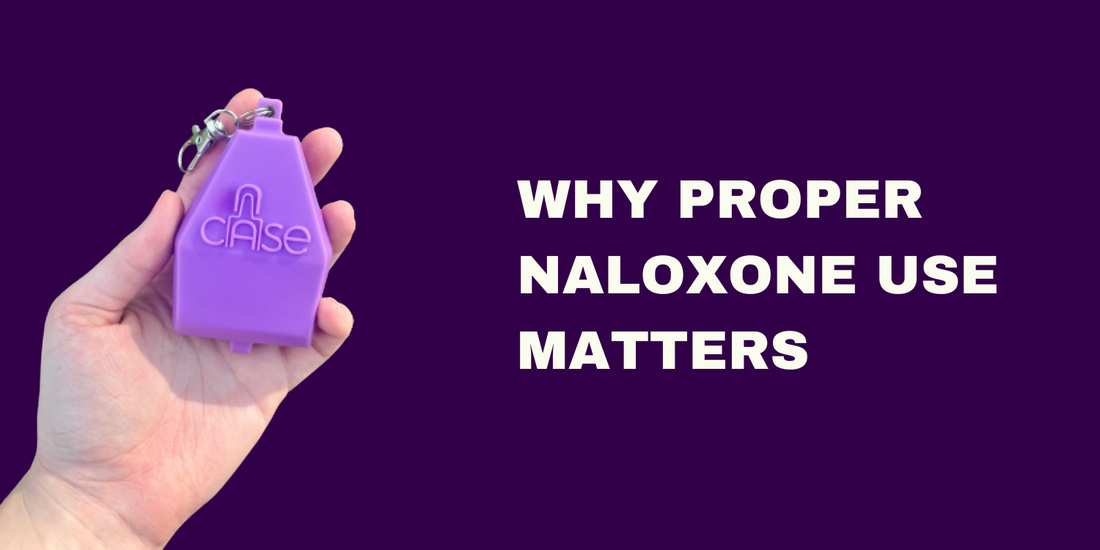
Common Mistakes to Avoid When Administering Naloxone
Share
Why Proper Naloxone Use Matters
Naloxone is a life-saving medication that can rapidly reverse an opioid overdose, but correct administration is crucial for its effectiveness. Even though naloxone is designed to be simple to use, mistakes can delay or reduce its effectiveness, putting the individual at greater risk.
By understanding the most common errors and how to avoid them, bystanders, caregivers, and first responders can ensure the best possible chance of survival for overdose victims.
In this guide, we cover:
● Common mistakes people make when administering naloxone
● How to use naloxone correctly in an emergency
● Why multiple doses may be needed
● How to prepare in advance with training and storage solutions
Avoid These Errors When Using Naloxone
Naloxone administration is straightforward, but in high-stress situations, it is easy to make critical errors. Here’s what to avoid:
1. Not Calling 911
One of the biggest mistakes people make is assuming naloxone alone is enough to save a life. While naloxone reverses opioid effects, it does not last long, and some opioids—especially fentanyl and synthetic analogs—stay in the body much longer than naloxone’s 30 to 90-minute window.
Why 911 Must Be Called Immediately
● The individual could stop breathing again after naloxone wears off.
● Some overdoses require multiple doses of naloxone to be fully reversed.
● Medical professionals can monitor for other complications, including non-opioid drugs in the system.
What to Tell 911
● Clearly state that you suspect an opioid overdose.
● Inform them naloxone has been administered and how many doses were given.
● If the person is still unresponsive after two to three minutes, administer another dose and continue monitoring.
What Not to Do
● Do not assume the person is fine just because they wake up. They still need immediate medical attention.
● Do not leave the individual alone—stay with them until emergency responders arrive.
2. Improper Nasal Spray Technique
Most people use naloxone nasal spray (Narcan) because it is easy and requires no medical training. However, incorrect usage can reduce effectiveness or delay overdose reversal.
How to Properly Administer Naloxone Nasal Spray
- Lay the person on their back.
- Tilt their head slightly back for proper airflow.
- Insert the nozzle into one nostril—make sure it is fully inside.
- Press the plunger firmly until the full dose is released.
- Do not test spray beforehand—each unit contains only one dose.
If the person does not respond within two to three minutes, administer a second dose in the other nostril.
Common Mistakes People Make
● Spraying without inserting the nozzle fully into the nostril.
● Not pressing the plunger all the way down.
● Waiting too long to give a second dose if the first does not work.
How to Ensure Proper Administration
● Store naloxone in a naloxone nasal spray case for easy access in an emergency.
● Familiarize yourself with how naloxone works before an overdose happens.
3. Not Administering a Second Dose When Needed
One of the biggest misconceptions about naloxone is that one dose is always enough. In reality, some overdoses require multiple doses—especially if fentanyl or other potent opioids are involved.
Why Some Overdoses Need More Than One Dose
● Fentanyl is 50 times stronger than heroin and requires more naloxone to reverse.
● Some opioids stay in the system longer than naloxone's effects, causing a re-overdose after the first dose wears off.
● If no improvement is seen after two to three minutes, immediately administer another dose.
When to Give a Second Dose
● If the person does not wake up or breathe normally after the first dose.
● If symptoms improve but then worsen within 30 minutes (re-overdose).
● If emergency responders are delayed and the person remains unconscious.
Keeping multiple doses in a naloxone carrying case ensures you always have enough in an emergency.
Training and Preparedness: Why Practice Matters
Naloxone works best when administered quickly and correctly, but in a stressful situation, hesitation or confusion can cost precious seconds.
1. Take a Free Naloxone Training Session
Many community health centers, harm reduction organizations, and public health departments offer free naloxone training. These sessions cover:
● How to recognize an overdose.
● How to administer naloxone correctly.
● What to do after naloxone is given.
Where to Find Naloxone Training
● Local harm reduction programs.
● Community health clinics.
● Online video guides from public health organizations.
Regular practice ensures you are prepared when an emergency happens.
2. Keep Naloxone in a Safe, Accessible Location
A common mistake is not having naloxone easily accessible when it is needed. Emergencies happen fast—having naloxone stored correctly ensures you can respond immediately.
Best Storage Practices
● Keep naloxone in a protective carrying case to prevent damage.
● Store it in a cool, dry place—avoid extreme heat or cold.
● Have multiple doses available in case a second administration is needed.
Ideal Storage Options for Quick Access
● Naloxone keychain case – Best for personal carry.
● Tactical naloxone nasal spray holder – Ideal for first responders or high-risk situations.
● Indoor public access Narcan cases – Essential for businesses, schools, and transit hubs.
Final Thoughts: Every Second Counts in an Overdose Emergency
Naloxone is a powerful, life-saving tool, but correct administration is key. Avoiding common mistakes—calling 911, using proper technique, and knowing when to give multiple doses—ensures that naloxone works effectively in critical moments.
Be Prepared, Stay Informed, and Carry Naloxone
● Take a free naloxone training session to build confidence.
● Store naloxone in a naloxone carrying pouch for quick, easy access.
● Educate others about proper naloxone use and overdose response.
Every life saved counts. Carry naloxone and be ready to act.
Get your naloxone kit today and be prepared to save a life.


